Appliances
What Are the Disadvantages of Ceiling Fan?

Are ceiling fans truly as flawless as they appear?
While they provide a cost-effective and energy-efficient way to cool down a room, they also come with their fair share of drawbacks.
In this article, we will explore the disadvantages of ceiling fans, uncovering the potential downsides that often go unnoticed.
From the noise levels that can disrupt a peaceful environment to the limited cooling capabilities in larger spaces, it's important to consider all aspects before relying solely on this cooling solution.
Additionally, we will delve into the maintenance requirements, energy consumption, and limited control options that may make you reconsider the use of ceiling fans.
So, let's take a closer look at the disadvantages that accompany these seemingly perfect fixtures.
Key Takeaways
- Ceiling fans can generate noise and vibration, which can disrupt a peaceful environment.
- Ceiling fans have limited cooling capabilities and cannot effectively lower the temperature like an air conditioner.
- Inefficient air circulation compromises the cooling effect of ceiling fans, especially in larger spaces.
- Ceiling fan aesthetics are often limited, making it challenging to find a fan that matches the overall interior design scheme.
Noise Levels
Ceiling fans can produce varying levels of noise, which can be a disadvantage for those seeking a quiet and peaceful environment. When choosing a ceiling fan, it's important to consider the noise levels it produces. Excessive noise can be a nuisance and disrupt sleep or concentration.
The noise produced by a ceiling fan is primarily due to the movement of its blades and motor. Factors such as blade design, motor quality, and installation can all contribute to the level of noise generated. Manufacturers strive to minimize noise by using noise reduction techniques and improving vibration levels.
To achieve limited noise levels, ceiling fan manufacturers employ various strategies. One approach is to use high-quality motors that operate smoothly and quietly. These motors are designed to minimize vibrations, which can cause noise. Additionally, manufacturers focus on blade design and materials to reduce noise generated by air movement.
Noise reduction techniques also involve proper installation. Improperly installed ceiling fans can create unnecessary noise due to loose or unbalanced components. Ensuring a secure and stable installation can help minimize noise levels.
To summarize, it's crucial to consider noise levels when selecting a ceiling fan to create a peaceful environment. Understanding the factors that contribute to noise production and the implementation of noise reduction techniques can help achieve a quiet and serene space.
Limited Cooling Capabilities

When considering the disadvantages of ceiling fans, it's important to acknowledge their limited cooling capabilities.
Ceiling fans are designed to circulate air within a room, but they don't actually lower the temperature.
This means that while they may create a breeze and provide a perceived cooling effect, they can't effectively cool down a space in the same way that an air conditioner can.
Therefore, it's important to understand the limitations of ceiling fans when seeking to achieve optimal cooling in a room.
Inefficient Air Circulation
The limited cooling capabilities of ceiling fans can be attributed to their inefficient air circulation. Ceiling fans rely on the movement of air to create a cooling effect, but if the airflow is inefficient, the cooling effect will be compromised.
Inefficient airflow refers to the inability of the fan to effectively move air throughout the room, resulting in poor ventilation. This can be caused by various factors, such as the size and design of the fan blades, the motor power, and the positioning of the fan.
When air circulation is inefficient, the fan may only provide a localized cooling effect near its location, leaving other areas of the room unaffected. This limitation can make it challenging to achieve an evenly distributed and consistent cooling effect in larger spaces.
Noise and Vibration
Are there any drawbacks to the limited cooling capabilities of ceiling fans, such as noise and vibration?
While ceiling fans are effective at providing a gentle breeze, they can sometimes produce excessive noise and vibration, which can be a nuisance for users. The noise is typically caused by several factors, including the motor, blades, and loose components.
To reduce noise, regular maintenance is essential. Lubricating the motor and ensuring that all screws and bolts are tightened can help minimize vibration and noise. Additionally, choosing a fan with noise reduction features such as rubberized components can also help.
It's important to note that noise levels can vary depending on the quality and design of the fan. Therefore, when purchasing a ceiling fan, it's advisable to consider models that are specifically designed for quiet operation.
Limited Aesthetic Options
Moving on to the limited aesthetic options of ceiling fans, it's important to consider how these options may affect their cooling capabilities.
Ceiling fan aesthetics are often restricted due to design limitations. The traditional design of ceiling fans tends to be bulky and unappealing to some homeowners who prioritize modern and sleek decor. This limited range of design options can make it challenging for individuals to find a ceiling fan that seamlessly integrates into their overall interior design scheme.
However, it's crucial to note that while aesthetics may be limited, the cooling capabilities of ceiling fans aren't compromised. The design limitations don't impact the fan's ability to circulate air effectively and provide a cooling breeze.
Therefore, despite the limited options in terms of aesthetics, ceiling fans remain a reliable cooling solution for many households.
Maintenance Requirements
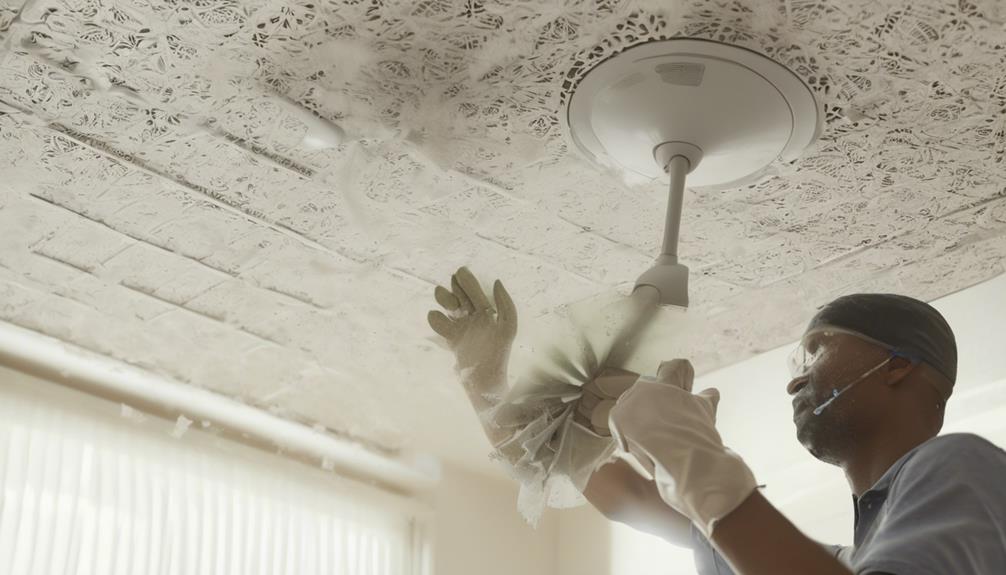
Regular maintenance is essential for ensuring the optimal performance and longevity of ceiling fans. Neglecting maintenance can lead to various issues such as decreased efficiency, increased noise levels, and even potential safety hazards. To help you understand the maintenance requirements of ceiling fans, let's analyze the associated maintenance costs and lifespan.
| Maintenance Requirements | Cost Analysis | Lifespan Analysis |
|---|---|---|
| Cleaning | Low | Prolongs lifespan |
| Lubrication | Low | Improves efficiency |
| Motor inspection | Medium | Detects potential issues |
Cleaning the ceiling fan regularly is a crucial maintenance task. Accumulated dust can hinder the fan's performance and increase energy consumption. By cleaning the blades and motor housing, you can ensure that the fan operates smoothly and efficiently. Lubricating the fan's moving parts, such as the bearings, can reduce friction and noise, as well as improve overall performance. It is important to inspect the motor regularly for any signs of wear or damage, as this can impact the fan's lifespan and safety. Identifying and addressing motor issues early can help prevent costly repairs or replacements.
Energy Consumption
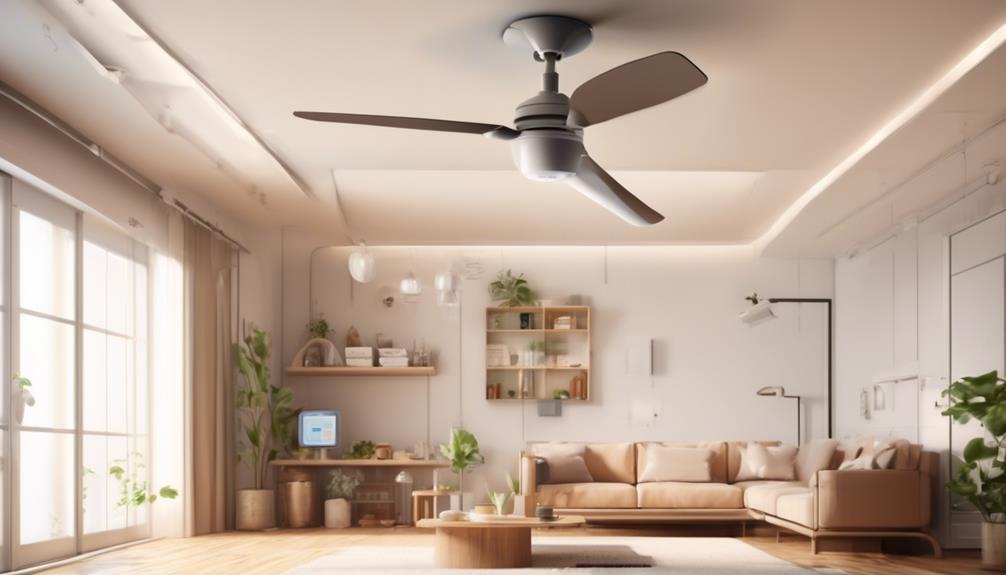
When it comes to energy consumption, ceiling fans have a few disadvantages.
Firstly, they tend to have high electricity usage, especially when compared to more energy-efficient options such as air conditioners.
Additionally, ceiling fans have limited cooling capacity, meaning they may not be able to effectively cool large spaces or provide adequate relief during extremely hot weather.
These factors should be considered when deciding on the most suitable cooling solution for a particular space.
High Electricity Usage
Ceiling fans consume a significant amount of electricity, which can lead to high energy usage and increased utility bills. While ceiling fans are a popular choice for cooling and air circulation, their high electricity consumption can pose a disadvantage for homeowners. This is especially true in regions with high energy costs or during hot summer months when the fans are used frequently.
Additionally, ceiling fans require regular maintenance to ensure optimal performance and energy efficiency. Dust accumulation on the blades can reduce airflow and cause the fan to work harder, increasing its electricity usage.
Therefore, homeowners should be mindful of the potential high electricity usage of ceiling fans and consider energy-efficient alternatives or strategies to mitigate the associated costs.
Limited Cooling Capacity
Given the high electricity usage of ceiling fans, it's important to consider their limited cooling capacity in relation to energy consumption. Ceiling fans aren't as effective as air conditioners in cooling a room. While they can create a breeze that provides a cooling sensation, they don't actually lower the temperature of the air.
This is because ceiling fans work by circulating air rather than cooling it. As a result, they're unable to efficiently cool large spaces or rooms with high heat loads. Additionally, ceiling fans are less effective in humid climates as they don't remove moisture from the air.
Therefore, if you're looking for a cooling solution that can effectively lower the temperature of a room, ceiling fans may not be the most suitable option due to their inefficient cooling and limited cooling capacity.
Ineffective in Large Spaces

In large spaces, ceiling fans may prove to be ineffective due to their limited reach and air circulation capabilities. While ceiling fans are generally effective in small to medium-sized rooms, they often struggle to provide sufficient cooling and air circulation in larger areas. This limitation stems from the fact that ceiling fans rely on air movement to create a cooling effect, rather than actually lowering the temperature of the room. As a result, the effectiveness of a ceiling fan diminishes as the size of the space increases.
To illustrate this point, let's take a look at the following table, which compares the air circulation capabilities of ceiling fans in different room sizes:
| Room Size | Ceiling Fan Effectiveness |
|---|---|
| Small | High |
| Medium | Moderate |
| Large | Low |
As the table demonstrates, ceiling fans become less effective in larger spaces, offering only limited air circulation. This can lead to inefficient cooling, leaving certain areas of the room feeling warm and stuffy. Additionally, the limited reach of ceiling fans means that they may not be able to effectively distribute cool air throughout the entire space, resulting in uneven cooling and discomfort for occupants.
Therefore, in large spaces, alternative cooling solutions such as air conditioners or multiple ceiling fans may be necessary to ensure optimal air circulation and temperature control.
Potential for Wobbling
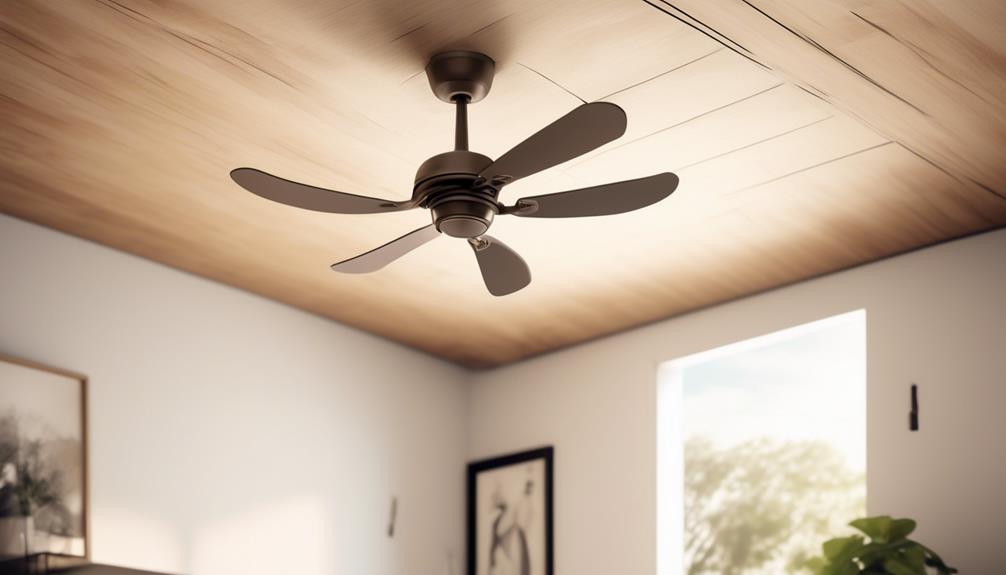
The potential for wobbling is a common concern when it comes to ceiling fans. Wobbling can occur due to various factors, such as improper installation, unbalanced fan blades, or motor issues. When a ceiling fan wobbles, it not only affects its performance but also poses a safety risk. This is why it's essential to address the issue promptly.
To prevent wobbling, regular maintenance is crucial. It's important to ensure that the fan is installed correctly, with all the necessary hardware securely fastened. Additionally, checking and balancing the fan blades periodically can help minimize wobbling. If the fan continues to wobble despite these efforts, it may indicate a motor problem, which should be addressed by a professional.
Wobbling ceiling fans can also contribute to increased maintenance requirements. The vibrations caused by the wobbling can loosen screws and other components, leading to more frequent repairs. Moreover, excessive wobbling can cause the fan to wear out faster, requiring replacement sooner than anticipated.
Aside from maintenance concerns, wobbling ceiling fans can also lead to high electricity usage. The imbalance in the fan can result in increased friction and resistance, causing the motor to work harder to maintain its speed. This extra strain on the motor can lead to higher energy consumption, resulting in increased electricity bills.
Limited Design Options

Ceiling fans often have limited design options, which can restrict the ability to match the fan with the overall aesthetic of a space. While ceiling fans are highly functional and efficient in providing air circulation, their design options can be lacking. This can be a disadvantage for those who prioritize design flexibility and want their ceiling fan to seamlessly blend into the decor of their space.
One of the main limitations of ceiling fan design options is the lack of alternative options in terms of styles, colors, and finishes. Most ceiling fans come in basic designs and standard colors, such as white, black, or wood finishes. This limited selection can make it challenging to find a fan that complements the existing interior design elements.
To illustrate the limited design options of ceiling fans, consider the following table:
| Design Aspect | Limitations |
|---|---|
| Style | Few options beyond traditional or modern designs |
| Color | Limited range of standard colors available |
| Finish | Few choices beyond standard wood or metal finishes |
These limitations can restrict the design flexibility and make it harder to find a ceiling fan that matches the desired aesthetic of a space. However, it's worth noting that some manufacturers are introducing more versatile and customizable options to address this limitation. Nonetheless, the limited design options of ceiling fans remain a potential disadvantage for those seeking a broader range of choices in their home decor.
Difficult Installation Process
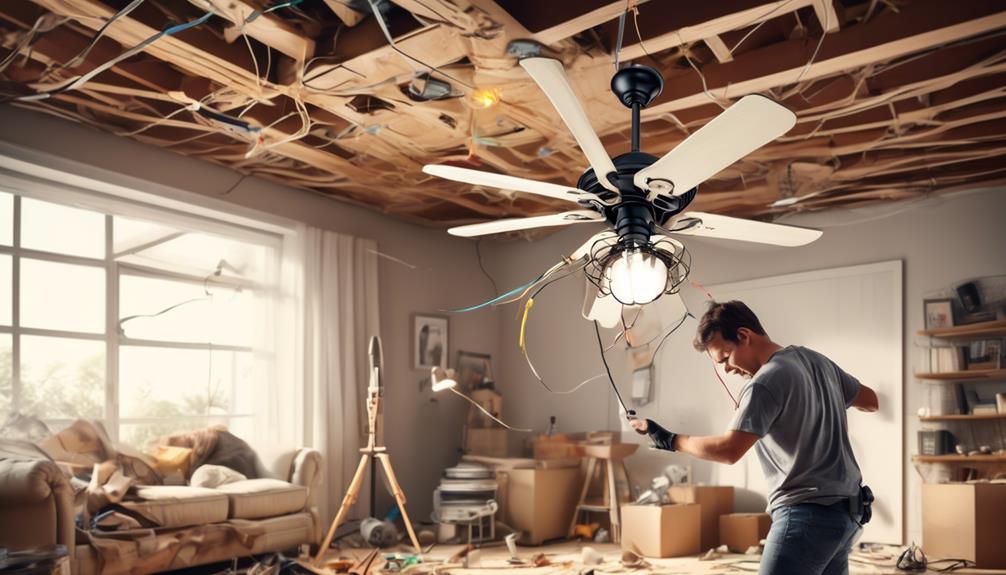
Installing a ceiling fan can be a challenging and complex process, requiring careful attention to detail and technical expertise. The difficulty of the installation process is one of the disadvantages of ceiling fans that homeowners should consider. Here are some reasons why the installation process can be difficult:
- Wiring complications: Ceiling fans require electrical wiring connections, which can be complicated for those without experience in electrical work. Incorrect wiring can lead to malfunctions or even pose safety hazards.
- Mounting challenges: Properly mounting a ceiling fan requires finding a suitable location and ensuring the ceiling can support the weight. This can be especially difficult in older homes with unconventional ceiling structures.
- Balance and stability: Achieving a balanced and stable installation is crucial to prevent wobbling or shaking of the fan. This requires careful adjustment of the mounting bracket and fan blades.
- Time-consuming process: Installing a ceiling fan can be time-consuming, especially for those who aren't familiar with the process. It may involve disassembling and reassembling parts, making it a lengthy endeavor.
Furthermore, the difficult installation process is compounded by the limited design options available for ceiling fans. While there are a variety of styles and finishes to choose from, homeowners may find that the options aren't as extensive as those for other types of lighting fixtures. This limited design selection can make it challenging to find a ceiling fan that perfectly matches the aesthetic of the room.
Risk of Injury From Fan Blades

When considering the disadvantages of ceiling fans, one important aspect to address is the risk of injury from fan blades.
Blade-related accidents can occur when individuals come into contact with the spinning blades, resulting in serious injuries such as cuts, bruises, or even amputations.
These safety concerns highlight the need for proper caution and awareness when operating ceiling fans, as well as the importance of implementing safety features to mitigate the risk of injury.
Blade-Related Accidents
Blade-related accidents pose a significant risk of injury when operating ceiling fans. It's crucial to prioritize blade maintenance and follow proper safety precautions to minimize the chances of accidents. Here are four key points to consider:
- Blade balance: Ensuring that fan blades are properly balanced is essential to prevent wobbling, which can lead to blades coming loose or detaching altogether. Regularly inspecting and adjusting blade balance is crucial for safe operation.
- Blade cleaning: Dust and debris accumulation on fan blades can affect their performance and increase the risk of accidents. Regularly cleaning the blades using a soft cloth or brush can prevent these issues.
- Blade clearance: Maintaining a safe distance between the blades and surrounding objects is vital. Ensure that the fan is installed at a recommended height and that there's sufficient clearance to avoid potential injuries or damage.
- Blade speed: Understanding and adhering to the recommended speed settings for your ceiling fan is crucial. Running the fan at excessively high speeds can increase the risk of accidents and should be avoided.
Safety Concerns
Ceiling fans pose a significant safety concern due to the risk of injury from fan blades. While ceiling fans provide comfort and air circulation, proper safety precautions must be taken to prevent accidents.
It's essential to follow guidelines provided by manufacturers regarding installation and maintenance to minimize the risk of injury. Regularly checking and tightening the fan blades and ensuring that they're securely attached is crucial.
Additionally, it's important to keep a safe distance from the fan blades while the fan is in operation. Electrical hazards are also a safety concern when using ceiling fans. Ensuring that the fan is properly grounded and that all electrical connections are secure is essential to prevent any potential electrical accidents.
Not Suitable for Low Ceilings
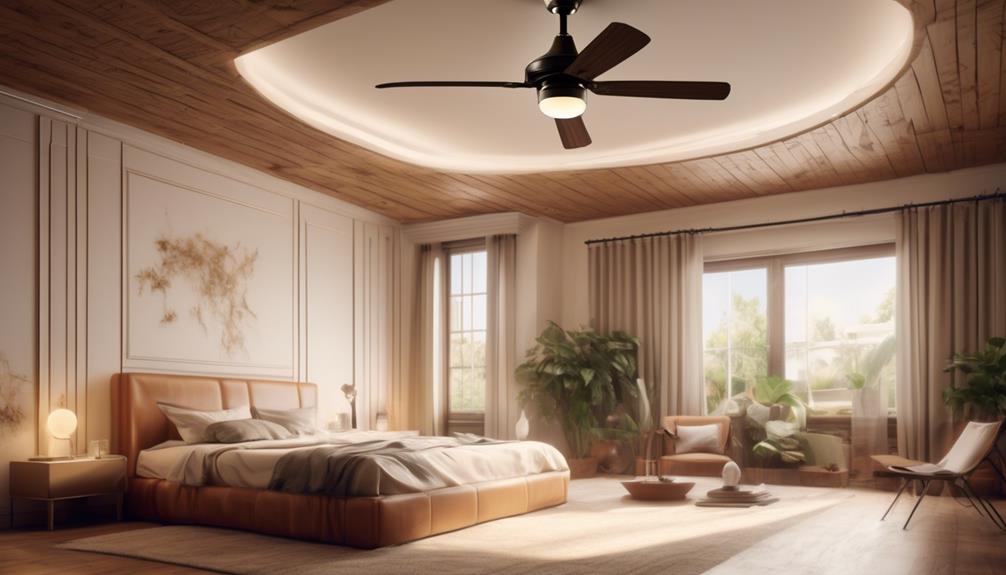
Are there any limitations to using ceiling fans in rooms with low ceilings?
Absolutely. When it comes to low ceilings, ceiling fans may not be the most suitable cooling option. Here are some reasons why:
- Insufficient airflow: Low ceilings restrict the movement of air, resulting in limited circulation. Ceiling fans require a sufficient distance between the blades and the ceiling to effectively create air movement. In rooms with low ceilings, this distance is reduced, leading to reduced airflow and less effective cooling.
- Safety concerns: Installing a ceiling fan in a room with low ceilings increases the risk of accidents. The blades of the fan may come dangerously close to the ceiling, potentially causing damage or injury.
- Limited design options: Low ceilings limit the design options for ceiling fans. Many ceiling fan models are designed with a specific blade length and configuration, which may not be suitable for low ceilings. Finding a ceiling fan that fits the space and provides adequate cooling can be challenging.
- Low ceiling alternatives: For rooms with low ceilings, alternative cooling options such as portable fans, wall-mounted fans, or air conditioning units may be more suitable. These alternatives can provide efficient cooling without the limitations posed by low ceilings.
Considering these limitations, it's important to explore alternative cooling options that are better suited for rooms with low ceilings.
Potential for Dust Accumulation
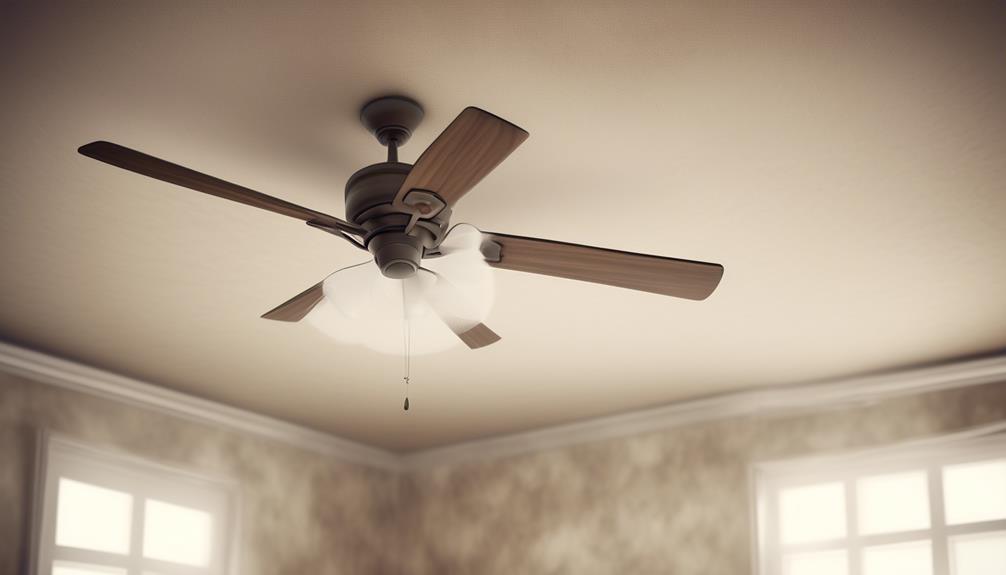
Considering the limitations of ceiling fans in rooms with low ceilings, it's important to now address the potential for dust accumulation.
Ceiling fans, while efficient at circulating air and providing cooling in a room, also have a downside when it comes to dust accumulation. Due to their constant rotation and the upward airflow they create, ceiling fans tend to attract and accumulate dust particles over time. This can be a concern for individuals with allergies or respiratory issues, as the accumulated dust can circulate back into the room when the fan is turned on.
To mitigate the potential dust accumulation, regular maintenance is crucial. Ceiling fans require periodic cleaning to remove the accumulated dust. This can be done by using a soft cloth or a duster to gently wipe the fan blades, ensuring that the dust doesn't spread around the room. Additionally, some ceiling fans come with detachable blades, making it easier to clean them thoroughly.
Neglecting the maintenance requirements of a ceiling fan can lead to an increase in dust buildup, which not only affects the air quality but can also impact the fan's performance. The accumulated dust can cause the fan to become unbalanced, leading to wobbling or noise issues. Therefore, it's essential to include regular cleaning and maintenance of ceiling fans as part of your household routine.
Limited Control Options

When it comes to the limited control options of ceiling fans, there are a few key points to consider.
Firstly, remote control limitations can be a major disadvantage, as they often have a limited range and can easily be misplaced or lost.
Additionally, the lack of speed options can be frustrating for users who prefer more control over the airflow in their space.
Remote Control Limitations
To maximize the efficiency and convenience of operating a ceiling fan, it's important to be aware of the limitations associated with remote control options.
While remote controls offer several advantages, such as the ability to adjust fan speed and turn the fan on or off from a distance, there are certain limitations that users should consider.
These limitations include:
- Limited control options: Most ceiling fan remote controls have a limited number of buttons, which means that users may not have access to all the features and settings available on the fan itself.
- Interference issues: Remote controls can sometimes be affected by interference from other electronic devices or even neighboring fans, leading to inconsistent or unreliable operation.
- Battery dependency: Remote controls rely on batteries for power, and when the batteries run out, the remote may become non-functional until they're replaced.
- Compatibility concerns: Not all ceiling fans are compatible with remote controls, so users must ensure that their fan model supports remote control features before purchasing or installing one.
Understanding these limitations will help users make informed decisions when it comes to using remote controls for their ceiling fans.
Lack of Speed Options
One drawback of ceiling fans is the limited control options for adjusting fan speed. This lack of speed options can be inconvenient for individuals who prefer a specific fan speed for different situations. Ceiling fans typically come with only a few preset speed settings, such as low, medium, and high. This limited customization options can be frustrating for those who desire more control over their fan's speed.
Additionally, the impact on energy bills may be significant. If the available speed options don't suit the user's needs, they may end up running the fan at a higher speed than necessary, resulting in increased energy consumption and higher electricity bills. Therefore, it's important for consumers to carefully consider the available speed options when choosing a ceiling fan.
Interference With Other Electronics
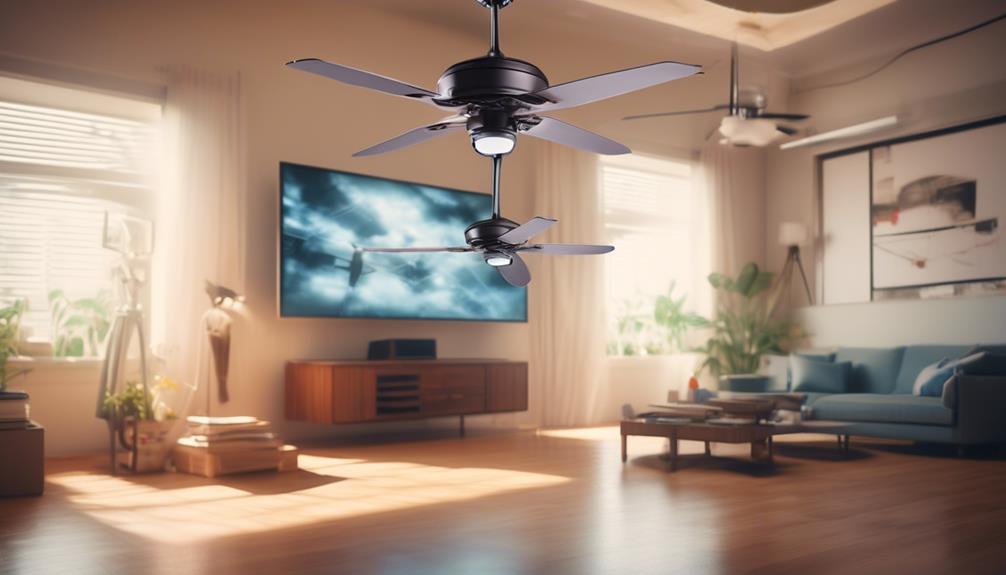
Ceiling fans can cause interference with other electronics, which can be a significant drawback to their usage. Interference issues arise due to the electromagnetic fields generated by the fan motor and its components. These fields can disrupt the functioning of nearby electronic devices, leading to compatibility problems and impacting their performance.
Here are some key points to consider regarding the interference caused by ceiling fans:
- Electromagnetic Interference (EMI): The fan motor's electromagnetic fields can interfere with the signals of electronic devices such as televisions, radios, and Wi-Fi routers. This interference can result in distorted audio or video, poor reception, or even complete signal loss.
- Radio Frequency Interference (RFI): Ceiling fans can emit radio frequency signals that may interfere with other wireless devices, such as cordless phones or wireless speakers. This interference can cause static, dropped calls, or reduced range.
- Control System Interference: Some ceiling fans come with remote control systems that operate on radio frequencies. These systems can interfere with other devices using similar frequencies, leading to operational issues or malfunctions.
- Shielding and Design: Proper shielding and design techniques can help minimize interference. Fans with better shielding and grounding mechanisms can reduce the chances of interference with other electronics.
It is important to consider these potential interference issues before installing a ceiling fan, especially in rooms where sensitive electronic devices are present. Proper placement, shielding, and selecting fans with low EMI and RFI emissions can help mitigate these compatibility problems and ensure a smooth user experience.
Inadequate Lighting Options
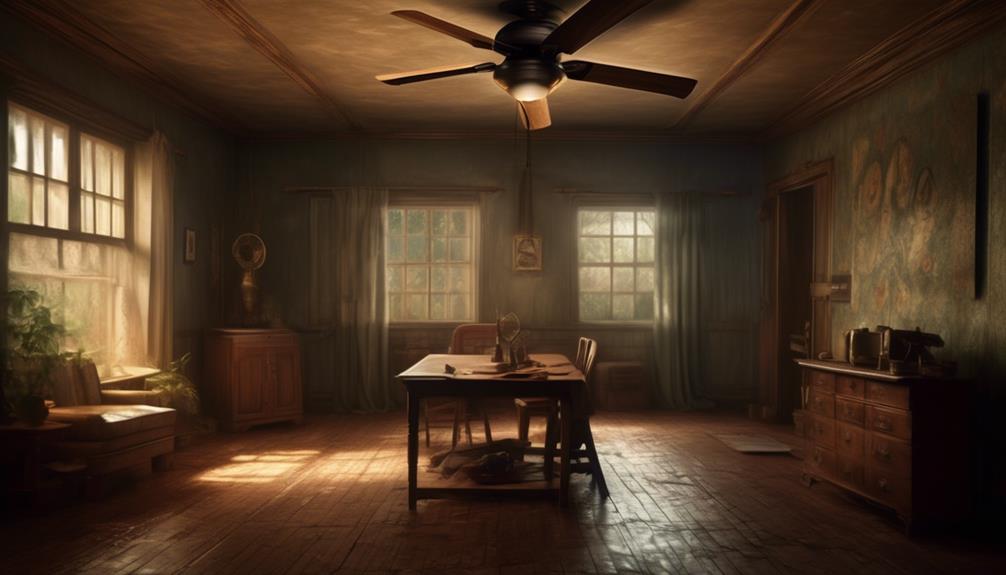
Given the potential drawbacks of interference caused by ceiling fans, it's important to also consider the issue of inadequate lighting options. While ceiling fans provide a great source of air circulation and can help to keep a room cool, their lighting capabilities may fall short.
Inadequate lighting options can be a significant disadvantage for those who rely on ceiling fans for both cooling and illumination.
One of the main concerns with ceiling fan lighting is the limited control options. Most ceiling fans come equipped with basic lighting features that may not provide sufficient brightness or flexibility. The built-in lights are often fixed in one direction, making it difficult to adjust the lighting to suit specific needs or preferences. This lack of control can be frustrating for individuals who require different levels of lighting for various activities, such as reading, working, or entertaining.
Furthermore, the limited lighting options of ceiling fans may not be suitable for larger or dimly lit spaces. The standard lighting fixtures on ceiling fans often have lower wattage or are designed to provide ambient lighting rather than focused task lighting. This can result in insufficient brightness, leaving certain areas of a room poorly illuminated.
Difficulty in Accessing Hard-To-Reach Areas
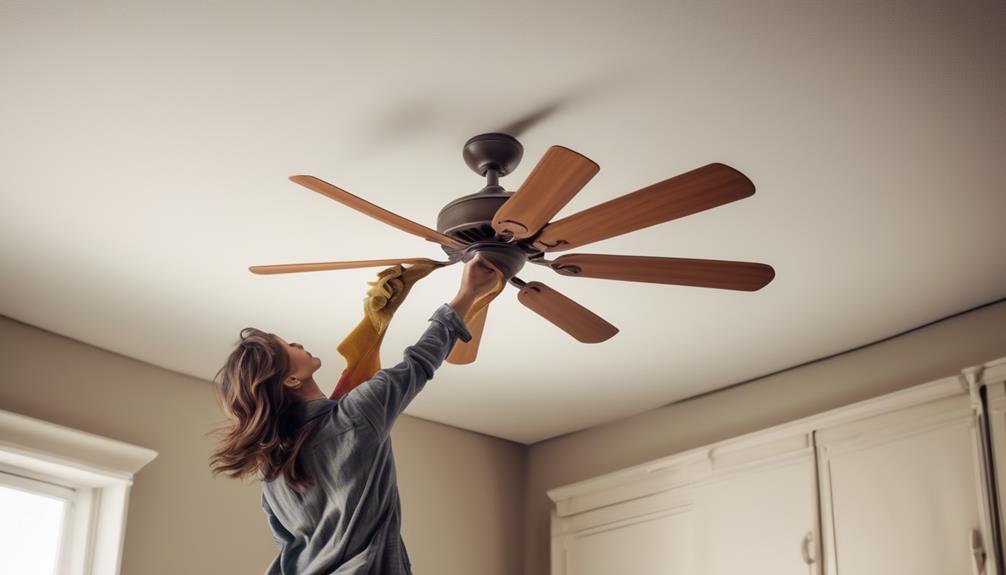
Accessing hard-to-reach areas can be a challenging task when it comes to ceiling fans. Due to their elevated position, ceiling fans often require regular maintenance to ensure optimal performance and safety. Here are some difficulties in maintaining hard-to-reach areas of ceiling fans:
- Limited accessibility: Ceiling fans are typically installed on high ceilings or in rooms with limited space, making it difficult to reach them for maintenance purposes. This can result in inconvenience and delays in cleaning or servicing the fan.
- Risk of accidents: Climbing ladders or using other tools to access hard-to-reach areas of a ceiling fan can pose safety hazards. Accidents such as falls or electrical shocks may occur if proper precautions aren't taken.
- Increased time and effort: Cleaning or repairing hard-to-reach areas of a ceiling fan can be time-consuming and physically demanding. It requires additional tools and techniques to effectively reach and clean the fan blades or other components.
- Need for professional assistance: In some cases, accessing hard-to-reach areas of a ceiling fan may require professional help. This adds to the maintenance costs and can be inconvenient for homeowners.
Can the Disadvantages of Ceiling Fans Outweigh the Advantages?
When considering the pros and cons of ceiling fans, it’s important to weigh the benefits against the drawbacks. While ceiling fans can help save on energy costs and provide a cool breeze, they can also be noisy and collect dust. It’s essential to consider the overall impact before installing one.
Frequently Asked Questions
Can Ceiling Fans Cause Interference With Other Electronic Devices in the Room?
When it comes to ceiling fans, one of the concerns that arise is whether they can cause interference with other electronic devices in the room. Interference issues and compatibility concerns are valid points to consider.
It's important to note that while some ceiling fans may generate electromagnetic fields, the impact on electronic devices is generally minimal. However, if you have sensitive or older electronic devices, it's advisable to keep them at a safe distance from the fan to avoid any potential interference.
Are There Any Lighting Options Available for Ceiling Fans?
When considering the lighting options for ceiling fans, it's important to analyze their energy consumption. By incorporating various lighting options, such as LED or CFL bulbs, ceiling fans can provide both illumination and energy efficiency.
These options allow for customization, enhancing the functionality and aesthetic appeal of the fan. However, it's crucial to be aware of any potential drawbacks, which we'll explore further when discussing the disadvantages of ceiling fans.
Are Ceiling Fans Difficult to Install?
Ceiling fans can be a bit tricky to install, but with the right guidance, it can be a smooth process. A ceiling fan installation guide can provide step-by-step instructions to help you through the process.
It's important to follow the instructions carefully and ensure that the fan is securely mounted to avoid any accidents.
Troubleshooting common ceiling fan problems, such as wobbling or noise, can also be addressed in the installation guide, making it a valuable resource for any ceiling fan owner.
Can Ceiling Fans Effectively Cool Large Spaces?
Ceiling fans can be an effective solution for cooling large spaces. Their performance is determined by factors such as blade size, motor power, and airflow. With the right specifications, a ceiling fan can circulate air efficiently, providing a cooling effect throughout the room.
Additionally, ceiling fans are energy-efficient compared to air conditioning units, consuming less electricity while still providing a comfortable environment. Considering their performance and energy efficiency, ceiling fans are a viable option for cooling large spaces.
Is It Possible to Access Hard-To-Reach Areas for Cleaning and Maintenance With Ceiling Fans Installed?
Accessing hard-to-reach areas for cleaning and maintenance with ceiling fans installed poses accessibility challenges. However, there are cleaning techniques that can help overcome these obstacles.
By utilizing specialized tools or extension poles, we can effectively clean and maintain ceiling fans in high or awkward spaces. This ensures that the fans continue to operate efficiently and prolongs their lifespan.
Regular cleaning also prevents the accumulation of dust, which can affect air quality and the overall performance of the fan.
Conclusion
In conclusion, while ceiling fans offer many advantages such as cost-effectiveness and energy efficiency, they also have their fair share of disadvantages.
From limited cooling capabilities and noise levels to maintenance requirements and inadequate lighting options, these drawbacks should be carefully considered before opting for a ceiling fan.
However, as the saying goes, every cloud has a silver lining. By understanding these limitations, we can make informed decisions and find ways to overcome them, ensuring a more comfortable living space.
- About the Author
- Latest Posts
Introducing Ron, the home decor aficionado at ByRetreat, whose passion for creating beautiful and inviting spaces is at the heart of his work. With his deep knowledge of home decor and his innate sense of style, Ron brings a wealth of expertise and a keen eye for detail to the ByRetreat team.
Ron’s love for home decor goes beyond aesthetics; he understands that our surroundings play a significant role in our overall well-being and productivity. With this in mind, Ron is dedicated to transforming remote workspaces into havens of comfort, functionality, and beauty.
Appliances
3 Essential Tips for RV-Friendly Portable Washers

- Pros and cons of using eco friendly laundry detergent in a portable washer.
- Tips for preventing detergent residue buildup in a portable washer
Are you exhausted from constantly looking for laundromats during your RV trips? We get it. That’s why we’re here to provide three key tips for RV-friendly portable washing machines.
While you might be thinking, ‘Do I really need a portable washer?’ trust us, having one on your RV can be a game-changer. In this guide, we’ll show you how to choose the right size washer that fits your RV’s limited space, understand the power and water requirements to ensure smooth operation, and provide you with maintenance and cleaning tips to keep your washer running efficiently.
So, let’s dive in and master the art of laundry on the road!
Key Takeaways
- Consider the laundry capacity needed for your RV.
- Look for compact and lightweight options with space-saving features.
- Choose a portable washer with high energy efficiency and water conservation features.
- Regularly maintain and clean your portable washer using recommended cleaning products.
Choosing the Right Size
One of the first considerations when selecting a portable washer for our RV is determining the appropriate size. Portable washer features and space-saving options play a crucial role in making this decision. When it comes to size, it’s important to find a washer that fits well within the limited space of an RV, while still providing enough capacity to meet our laundry needs.
To begin with, portable washers come in a range of sizes, typically measured in pounds of laundry capacity. It’s essential to consider the amount of laundry we anticipate doing on a regular basis. While a smaller capacity may be suitable for individuals or couples, larger families might require a washer with a higher capacity to accommodate their laundry demands.
Additionally, it’s important to consider the physical dimensions of the washer. RVs have limited space, so opting for a compact and lightweight washer can help maximize the available room. Some portable washers are designed with space-saving features such as folding handles, detachable components, or even stackable options that can fit neatly into tight spaces.
Understanding Power and Water Requirements
When considering the power and water requirements for our RV-friendly portable washer, we need to understand the necessary resources for optimal performance.
Energy efficiency is an important factor to consider when choosing a portable washer for your RV. Look for models that have a high Energy Star rating, as this indicates that they consume less energy and can help you save on your electricity bills.

Additionally, portable washer features such as load sensing technology and adjustable water levels can help you conserve water. These features ensure that the washer only uses the amount of water necessary to clean your laundry, which is particularly crucial when you have limited water supply in your RV.
It’s also important to check the power requirements of the portable washer. Make sure that the washer is compatible with the power source available in your RV, whether it’s a standard 120-volt outlet or a 12-volt DC power source.
Understanding the power and water requirements of your RV-friendly portable washer won’t only help you achieve optimal performance but also contribute to energy and water conservation.
Maintenance and Cleaning Tips
Let’s talk about how to properly maintain and clean your RV-friendly portable washer. Taking care of your portable washer is essential to ensure its longevity and optimal performance. Regular maintenance and cleaning will help prevent any potential issues and keep your machine running smoothly. Here are some common troubleshooting tips and recommended cleaning products to keep in mind:
| Common Troubleshooting | Recommended Cleaning Products |
|---|---|
| Leaking water | Vinegar and water mixture |
| Excessive noise | Mild detergent |
| Drum not spinning | Baking soda |
| Error codes | Citric acid |
If you encounter a problem such as leaking water, try using a mixture of vinegar and water to clean the machine’s seals and hoses. For excessive noise, use a mild detergent to clean the drum and remove any debris that may be causing the noise. If the drum is not spinning, try using baking soda to remove any buildup that may be hindering its movement. Lastly, if you receive error codes, using citric acid in the detergent compartment can help clean the sensors and resolve the issue.
Remember to always refer to your portable washer’s manual for specific maintenance instructions and troubleshooting tips. By following these guidelines and using the recommended cleaning products, you can keep your RV-friendly portable washer in great condition and enjoy clean laundry on your travels.
Frequently Asked Questions
How Long Does It Typically Take to Wash a Full Load of Laundry Using a Portable Washer?
Typically, it takes around 30 to 45 minutes to wash a full load of laundry using a portable washer.
However, it’s important to consider the capacity limitations of these machines. Most portable washers have a smaller capacity compared to traditional washers, so it may take longer if you have a larger load.
It’s always a good idea to follow the manufacturer’s instructions and not overload the machine to ensure efficient and effective washing.
Can I Use Regular Laundry Detergent in a Portable Washer, or Do I Need to Use a Specific Type?
Yes, you can use regular laundry detergent in a portable washer. However, there are some pros and cons to consider.
Using eco-friendly laundry detergent in a portable washer is a great option for those who want to reduce their environmental footprint. It can be gentler on your clothes and safer for the environment.
However, some eco-friendly detergents may not be as effective at removing tough stains. To prevent detergent residue buildup, make sure to use the recommended amount of detergent and run an extra rinse cycle if needed.
Is It Safe to Leave a Portable Washer Unattended While It’s Running?
Safety precautions should be taken when using a portable washer unattended. There are potential risks involved, such as water leakage or electrical malfunctions. It’s important to follow the manufacturer’s instructions and guidelines for safe operation.
Some tips to minimize risks include ensuring a stable surface, avoiding overloading the machine, and regularly checking for any signs of damage.
It’s always best to err on the side of caution when it comes to leaving a portable washer running without supervision.
Can I Wash Delicate Fabrics, Such as Silk or Lace, in a Portable Washer?
When it comes to washing delicate fabrics like silk or lace in a portable washer, there are a few things to keep in mind.
Firstly, check the manufacturer’s instructions to ensure that your specific model is suitable for these types of fabrics.
Secondly, use a gentle cycle and cold water to minimize any potential damage.
Lastly, consider placing delicate items in a mesh laundry bag for added protection.
With these precautions, you can safely wash your delicate fabrics in an RV-friendly portable washer.

How Noisy Are Portable Washers When in Operation?
When it comes to the noise level of portable washers, it’s important to consider their energy efficiency as well. These machines are designed to be compact and efficient, so they tend to operate quietly. While they do make some noise during operation, it’s typically minimal and shouldn’t disturb your RV neighbors or disrupt your peaceful campsite.
Plus, their energy efficiency means you can enjoy clean clothes without draining your RV’s power supply.
Conclusion
In conclusion, choosing the right size portable washer for your RV, understanding power and water requirements, and following maintenance and cleaning tips are essential for a smooth laundry experience on the road.
By coincidence, we stumbled upon a fellow traveler at a campsite who’d just purchased a portable washer based on our article. They were thrilled with the convenience and efficiency it provided.
So, take these tips into consideration and enjoy clean clothes wherever your adventures take you!
- About the Author
- Latest Posts
Introducing Charles, the Editor in Chief at ByRetreat, whose passion for interior design and editorial excellence elevates every remote workspace to new heights. With his keen eye for detail, impeccable taste, and expertise in design, Charles brings a wealth of knowledge and creativity to the ByRetreat team.
As the Editor in Chief of a renowned lifestyle blog, Charles has honed his skills in curating captivating content and staying up-to-date with the latest trends in interior design. His deep understanding of aesthetics and the power of storytelling through design enables him to create remote workspaces that are not only visually stunning but also rich in personality and meaning.
Appliances
4 Smart Tips for Extended Commercial Appliance Warranties

Did you realize that nearly 80% of commercial appliance malfunctions happen after the manufacturer’s warranty runs out? As business operators, we grasp the significance of safeguarding our assets and reducing unforeseen costs.
That’s why we have compiled four smart tips for extended commercial appliance warranties that will help you make informed decisions and ensure the longevity of your appliances.
In this guide, we will discuss choosing the right warranty provider, understanding coverage and exclusions, evaluating the cost and value, and maximizing the benefits of extended warranties.
By following these tips, you can have peace of mind knowing that your appliances are protected and your business operations can continue smoothly.
Let’s dive in and master the art of extended warranties!
Key Takeaways
- Choose a warranty provider with a good reputation and track record.
- Understand the coverage details and limitations of the warranty.
- Evaluate the cost and value of extended warranties.
- Maximize the benefits by understanding the claim process and maintaining your appliances.
Choosing the Right Warranty Provider
When selecting a warranty provider for extended commercial appliance warranties, we should consider their reputation and track record in the industry. Identifying reputable providers is crucial to ensure that we’re dealing with a company that has a history of delivering on their promises and providing excellent service to their customers. A reputable provider will have a strong presence in the market and positive reviews from satisfied clients. They’ll also have a proven track record of handling warranty claims efficiently and resolving issues promptly.
In addition to reputation, it’s important to compare warranty terms offered by different providers. We should carefully review the terms and conditions of each warranty to ensure that they meet our specific needs and requirements. This includes understanding the coverage provided, such as if it includes parts and labor costs, and the duration of the warranty. It’s also important to consider any limitations or exclusions that may apply.
Understanding Coverage and Exclusions
To fully understand the extent of coverage and any exclusions, we should carefully review the warranty terms and conditions for our extended commercial appliance warranties. Many people have common misconceptions about what’s covered under these warranties, which is why it’s so important to read the fine print. Here are some key points to consider:
- Scope of coverage: It’s crucial to understand what types of repairs or replacements are included in the warranty. This may vary depending on the provider and the specific appliance being covered. Some warranties may only cover certain parts or components, while others may offer more comprehensive coverage.
- Exclusions: Even though warranties provide coverage, there are often exclusions stated in the terms and conditions. These exclusions may include damage caused by misuse, neglect, or unauthorized repairs. It’s important to be aware of these exclusions to avoid any surprises when filing a claim.
- Duration of coverage: Extended commercial appliance warranties can vary in terms of their duration. Some warranties may provide coverage for a fixed period of time, while others may offer coverage until a certain number of repairs or replacements have been made. Understanding the duration of coverage can help us plan for future maintenance and repairs.
- Claim process: Familiarizing ourselves with the claim process is essential. This includes knowing who to contact, what documentation is required, and any specific procedures that need to be followed to ensure a smooth and efficient claim experience.
Evaluating the Cost and Value
To determine the cost-effectiveness of extended commercial appliance warranties, we need to assess their overall value. When weighing options and considering budget considerations, it is essential to evaluate the benefits and drawbacks of purchasing extended warranties for your appliances. To help you make an informed decision, we have created a table that outlines the key factors to consider:
| Factors to Consider | Benefits | Drawbacks |
|---|---|---|
| Coverage | Extended protection beyond the manufacturer’s warranty period | Additional cost |
| Repair Costs | Potential savings on repair expenses | Warranty cost may outweigh repair costs |
| Peace of Mind | Assurance that your appliances are protected | Limited likelihood of appliance failure |
By considering these factors, you can determine whether the cost of an extended warranty is justified by its value. It is important to note that budget considerations should not be the sole determining factor. While extended warranties may come at an additional cost, they can provide peace of mind and potential savings on repair expenses.
In the next section, we will explore strategies for maximizing the benefits of extended warranties, ensuring that you get the most value out of your investment.
Maximizing the Benefits of Extended Warranties
To maximize the benefits of extended warranties, we can employ strategies that optimize our investment. By understanding the claim process and exploring renewal options, we can ensure that our commercial appliance warranties provide us with the maximum value and protection.
Here are some smart tips for maximizing the benefits of extended warranties:
- Thoroughly understand the claim process: Familiarize yourself with the steps involved in filing a claim. Know the required documentation, such as proof of purchase and warranty information. By being prepared, you can expedite the claim process and minimize downtime.
- Regularly maintain your appliances: Proper maintenance is crucial for the longevity and performance of your commercial appliances. Follow the manufacturer’s guidelines for cleaning, servicing, and inspections. Regular maintenance not only extends the lifespan of your appliances but also helps prevent potential issues that may require warranty claims.
- Research renewal options: When your extended warranty is about to expire, explore renewal options offered by the warranty provider. Some providers offer extended renewal plans with additional coverage, giving you continued peace of mind and protection for your investment.
- Keep warranty documents organized: Maintain a dedicated folder or digital file for all your warranty documents. This ensures easy access to necessary information when filing a claim or renewing your warranty.
Frequently Asked Questions
How Can I Extend the Warranty on My Commercial Appliance if It’s Already Expired?
To extend the warranty on your commercial appliance after it has expired, there are several renewal options available.
You can contact the manufacturer or a third-party warranty provider to inquire about their extended warranty programs. They may offer coverage plans specifically designed for appliances with expired warranty coverage.
It’s important to carefully review the terms and conditions, as well as the cost, of these extended warranty options to ensure they meet your needs and budget.
Are There Any Specific Requirements or Limitations for Obtaining an Extended Warranty for Commercial Appliances?
When obtaining an extended warranty for commercial appliances, it’s important to be aware of the common exclusions in extended warranty coverage. These may include wear and tear, cosmetic damage, and misuse or negligence.
To choose the right extended warranty, consider factors such as the length of coverage, cost, and reputation of the provider.
It’s also crucial to thoroughly read and understand the terms and conditions of the warranty to avoid any surprises down the line.
Can I Transfer My Extended Warranty to a New Owner if I Sell My Commercial Appliance?
Yes, you can transfer your extended warranty to a new owner if you sell your commercial appliance. This ensures that the warranty coverage for used appliances continues with the new owner.
It’s important to check the specific requirements and limitations of your extended warranty to ensure a smooth transfer process. By transferring the warranty, you provide peace of mind to the new owner and protect them against any unexpected repair or replacement costs.
What Happens if My Commercial Appliance Breaks Down Multiple Times During the Extended Warranty Period?
If your commercial appliance breaks down multiple times during the extended warranty period, you may be eligible for claim reimbursement. The repair or replacement timeline will depend on the terms and conditions of your warranty.
It’s important to thoroughly review the warranty agreement to understand the process and any limitations. Our team is here to help ensure that your claims are handled efficiently and that you receive the necessary repairs or replacements in a timely manner.
Is There a Limit to the Number of Claims I Can Make Under an Extended Warranty for My Commercial Appliance?
There are limitations to the number of claims we can make under an extended warranty for our commercial appliance.
However, it’s important to note that extended warranties offer numerous benefits for commercial appliances. They provide peace of mind by covering repairs and replacements, reducing downtime and maintenance costs.
Conclusion
In conclusion, when it comes to extended commercial appliance warranties, there are several crucial considerations to keep in mind.
Firstly, choosing the right provider is essential. It’s important to research and compare different warranty providers to ensure they have a good reputation and offer comprehensive coverage.
Understanding coverage and exclusions is also crucial. Businesses should carefully review the terms and conditions of the warranty to know exactly what is covered and what is not. This will help avoid any surprises or disappointments down the line.

Evaluating cost and value is another important factor. Businesses should consider the cost of the warranty in relation to the potential repair or replacement costs of the appliances. They should also assess the value of the warranty by considering additional benefits such as extended service hours or priority service.
Lastly, maximizing benefits is key. Businesses should take advantage of all the benefits offered by the warranty, such as regular maintenance or discounted repairs. This will help ensure the appliances are well-maintained and any issues are addressed promptly.
By following these smart tips, businesses can make informed decisions that protect their investments. Just like a well-oiled machine, a well-chosen warranty can provide peace of mind and keep the business running smoothly. So don’t leave your appliances vulnerable, take action and secure their longevity today.
- About the Author
- Latest Posts
Introducing Charles, the Editor in Chief at ByRetreat, whose passion for interior design and editorial excellence elevates every remote workspace to new heights. With his keen eye for detail, impeccable taste, and expertise in design, Charles brings a wealth of knowledge and creativity to the ByRetreat team.
As the Editor in Chief of a renowned lifestyle blog, Charles has honed his skills in curating captivating content and staying up-to-date with the latest trends in interior design. His deep understanding of aesthetics and the power of storytelling through design enables him to create remote workspaces that are not only visually stunning but also rich in personality and meaning.
Appliances
3 Essential DIY HVAC Maintenance Tips Unveiled

Ah, the pleasures of tending to our HVAC systems! We understand the excitement of dedicating our valuable time to the upkeep and repair of these marvelous devices. But do not worry, dear reader, as we have revealed the tips to becoming skilled at DIY HVAC maintenance.
In this guide, we will unveil three essential tips that will ensure your HVAC system remains in perfect harmony. Get ready to dive into the world of air filters, thermostat settings, and outdoor condenser units. We will show you how to clean, check, and clear with ease, all while achieving that coveted mastery over your HVAC system.
So, let’s roll up our sleeves and get down to business, shall we?
Key Takeaways
- Regular maintenance, including cleaning air filters and checking thermostat settings, is essential for optimal HVAC system performance.
- Cleaning or replacing air filters prevents clogging and maintains a healthy indoor environment.
- Checking and maintaining thermostat settings ensures accurate temperature control and programming.
- Clearing debris from the outdoor condenser unit improves its performance and prevents airflow restriction.
Cleaning Air Filters Regularly
We recommend cleaning air filters regularly to ensure proper airflow and maintain optimal HVAC system performance. Replacing air filters is a crucial part of HVAC maintenance that often gets overlooked.
Air filters play a significant role in improving indoor air quality by capturing dust, pollen, and other airborne particles. Over time, these particles can accumulate on the filters, causing them to become clogged and obstructing the airflow. This can result in reduced efficiency and increased energy consumption.
By cleaning or replacing air filters on a regular basis, you can prevent these issues and maintain a healthy indoor environment.
Cleaning air filters is a relatively simple task that can be done by the homeowner. Start by turning off the HVAC system and locating the air filter. Remove the filter and inspect it for any visible dirt or debris. If the filter is washable, gently clean it with water and a mild detergent. Allow it to dry thoroughly before reinstalling. If the filter isn’t washable, it should be replaced with a new one. Remember to check the manufacturer’s recommendations for the appropriate filter type and replacement schedule.
Checking and Maintaining Thermostat Settings
To ensure optimal HVAC system performance, it’s important to regularly check and maintain the thermostat settings. The thermostat acts as the control center for your heating and cooling system, allowing you to adjust the temperature and program a schedule that suits your needs.
Start by adjusting the temperature settings to the desired level. This can be done manually or through programming. If you prefer a consistent temperature throughout the day, programming a schedule can help save energy and maintain comfort. Make sure to set different temperatures for when you’re away from home or asleep.
Regularly check the accuracy of your thermostat by comparing it to a separate thermometer. If there’s a discrepancy, recalibrate the thermostat to ensure accurate readings.
Keep the thermostat clean and free from dust and debris. Use a soft cloth to wipe away any buildup that may affect its functionality.
Lastly, check the batteries in your thermostat. Dead or low batteries can cause the thermostat to malfunction. Replace them as needed to ensure proper operation.
Clearing Debris From Outdoor Condenser Unit
Clearing debris from the outdoor condenser unit involves removing any dirt, leaves, and other obstructions that can hinder its performance. It’s important to regularly inspect and clean the condenser coil to ensure optimal functioning of the HVAC system.
To begin, it’s crucial to remove any vegetation that may have grown around the outdoor condenser unit. Plants, shrubs, or trees that are too close to the unit can restrict airflow and reduce its efficiency. Cut back any overhanging branches or foliage that may block the airflow and impede the unit’s ability to cool the air effectively.
Next, inspect the condenser coil for any debris buildup. Over time, dirt, leaves, and other particles can accumulate on the coil, obstructing the airflow and reducing its heat transfer capabilities. Gently brush away any debris using a soft-bristle brush or a vacuum cleaner with a brush attachment. Be careful not to damage the delicate fins of the coil during the cleaning process.
In addition to removing debris, it’s essential to inspect the coil for any signs of damage or corrosion. If any bent fins are detected, use a fin comb to straighten them out carefully. If there’s significant damage or corrosion, it’s recommended to contact a professional HVAC technician for further assessment and repair.
Regularly clearing debris and maintaining the condenser coil will help ensure that the outdoor unit operates efficiently and prolong its lifespan. By following these simple steps, you can optimize the performance of your HVAC system and maintain a comfortable indoor environment.
Frequently Asked Questions
How Often Should I Clean or Replace My Air Filters?
To improve the air quality in our homes, it’s essential to clean or replace air filters regularly. So, how often should we clean or replace them?
It’s recommended to clean or replace air filters every 1 to 3 months, depending on factors like the type of filter, the level of pollutants, and the frequency of HVAC system usage. Regular maintenance ensures that the air flowing through our HVAC system is clean and healthy, promoting a comfortable and safe living environment.
Can I Use Any Type of Air Filter for My HVAC System?
Can we use any type of air filter for our HVAC system?

It’s important to understand that not all air filters are created equal. There are different types of air filters available in the market, each with its own specifications and benefits.
Using the right filter for your HVAC system is crucial in ensuring optimal performance and indoor air quality. It’s recommended to consult with a professional to determine the best filter for your specific system and needs.
Are There Any Specific Thermostat Settings I Should Be Aware of During Different Seasons?
During different seasons, it’s important to adjust thermostat programming to maximize energy efficiency. By setting higher temperatures in the summer and lower temperatures in the winter, you can reduce the workload on your HVAC system and save on energy costs.
Additionally, utilizing programmable thermostats can help automate these adjustments, ensuring optimal comfort and efficiency.
How Can I Determine if the Outdoor Condenser Unit Is Blocked by Debris?
To determine if the outdoor condenser unit is blocked by debris, we can look for certain signs.
One key indicator is reduced airflow coming from the unit. If you notice that the air isn’t flowing as strongly as before, it could be a sign of blockage.
Another sign to watch out for is unusual noises coming from the condenser, which could indicate damage.
Regularly inspecting and cleaning the unit will help prevent any potential issues and ensure optimal performance.
What Are the Potential Consequences of Not Regularly Cleaning the Air Filters or Clearing Debris From the Outdoor Condenser Unit?
Neglecting HVAC maintenance can lead to serious consequences. Regularly cleaning air filters and clearing debris from the outdoor condenser unit is of utmost importance. Failure to do so can result in reduced airflow, decreased efficiency, and higher energy bills.
Additionally, dirty filters can lead to poor indoor air quality and potential health issues. By prioritizing regular HVAC maintenance, we ensure optimal performance, extend the lifespan of our system, and create a healthier and more comfortable living environment.
Conclusion
In conclusion, by regularly cleaning air filters, checking and maintaining thermostat settings, and clearing debris from the outdoor condenser unit, homeowners can ensure optimal performance and efficiency of their HVAC systems.
These essential DIY maintenance tips not only extend the lifespan of the system but also improve indoor air quality and reduce energy consumption.
By taking these simple steps, homeowners can enjoy a comfortable and healthy living environment while saving on utility bills.
- About the Author
- Latest Posts
Introducing Charles, the Editor in Chief at ByRetreat, whose passion for interior design and editorial excellence elevates every remote workspace to new heights. With his keen eye for detail, impeccable taste, and expertise in design, Charles brings a wealth of knowledge and creativity to the ByRetreat team.
As the Editor in Chief of a renowned lifestyle blog, Charles has honed his skills in curating captivating content and staying up-to-date with the latest trends in interior design. His deep understanding of aesthetics and the power of storytelling through design enables him to create remote workspaces that are not only visually stunning but also rich in personality and meaning.
-

 Vetted2 days ago
Vetted2 days ago15 Best Folding Beds for Small Spaces – Space-Saving Solutions for Comfort and Convenience
-

 Vetted20 hours ago
Vetted20 hours ago15 Best Waterproof Flooring Options for Your Bathroom – Ultimate Guide & Reviews
-

 Vetted6 days ago
Vetted6 days ago15 Best Grocery Carts to Make Shopping a Breeze
-

 Vetted2 weeks ago
Vetted2 weeks ago15 Best Gravel for Driveway: The Ultimate Guide for a Durable and Stunning Entrance
-

 Vetted4 days ago
Vetted4 days ago15 Best Steam Generators for Showering Bliss: Reviewed & Rated
-

 Beginners Guides3 weeks ago
Beginners Guides3 weeks agoI Inhaled Vinegar Fumes
-

 Vetted2 weeks ago
Vetted2 weeks ago15 Best Hot Tubs of 2024: Luxurious Relaxation at Your Fingertips
-

 Vetted4 weeks ago
Vetted4 weeks ago15 Best Blinds for Bathroom Windows to Enhance Privacy and Style


























